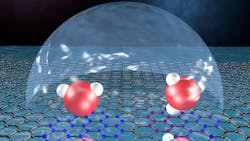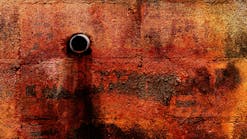VIRGINIA -- A recently published study led by Virginia Commonwealth University researchers sheds new light on how water interacts with the nanomaterial graphene, a single, thin layer of carbon atoms arranged in a hexagonal honeycomb lattice.
The researchers’ findings could hold implications for a variety of applications, including sensors, fuel cell membranes, water filtration, and graphene-based electrode materials in high-performance supercapacitors.
The study, “Solvent–Solvent Correlations across Graphene: The Effect of Image Charges,” was published in the American Chemical Society journal ACS Nano and was led by Neda Ojaghlou, Ph.D., who conducted the research as a doctoral student in the Department of Chemistry in the College of Humanities and Sciences.
The project addressed an important area of study for medicine, industry and science: Understanding how liquids — mainly water —interact with surfaces. These interactions are measured in several ways, but particularly by monitoring “wetting,” inferred from the shape of a drop on a surface. If a droplet is flat, the surface is considered “hydrophilic,” like a wet glass. If the droplet resembles a sphere, it is “hydrophobic,” like a droplet on a hot pan.
“An extremely important surface to study the wetting is a graphene sheet. Graphene is one of the most prominent nanomaterials,” Ojaghlou said. “Its chemical, electrical and mechanical properties underlie a wide range of applications from cellphones to tennis racquet production, and from electronic devices to car manufacturing. Graphene wetting is also important in biological surfaces and designing supercapacitors.”
In this study, the researchers investigated the enhanced graphene’s propensity to wet if there is water on the other side of the sheet. They used advanced computer simulations to study this effect at the molecular level.
“By improving the graphene model, we have shown for the first time how graphene’s conductivity leads to wetting transparency. Conductivity means the displacement of electric charges of carbon atoms to respond to the presence of water electric dipole moments. These electric fluctuations on carbon atoms, which are extremely hard to simulate, modulate the interaction of water molecules on the two sides of the sheet,” Ojaghlou said. “In short, we have taken the graphene conductivity into account, and that provides a much better explanation of the wetting of graphene when there is water on the other side.”
Dusan Bratko, Ph.D., professor in the Department of Chemistry and an author of the paper, said the findings are an important discovery.
"When in contact with water, graphene interferes with hydrogen bonds among the water molecules, replacing them with weaker dispersion attraction to carbon atoms. Nonetheless, neat graphene is found to be weakly hydrophilic. This is partly explained by the graphene’s conductivity, which adds an interesting attractive mechanism between aqueous dipoles and transient charges induced on carbon atoms,” Bratko said.
“A previously unknown feature unveiled by the team’s computational approach is the synergy of the induction effects when water is present on both sides of a graphene sheet,” he said. “In this new picture, graphene plays an active role in communicating between the opposing hydration layers. As a result, graphene is considerably easier to wet from both sides than from one side alone. This is important as the former scenario occurs in many practical applications. The two distinct behaviors have been indicated in experiments in water and can be expected with other dipolar and ionic liquids or solutions.”
Mahdi Shafiei, Ph.D., also a former doctoral student at VCU and author of the paper, said the team’s findings could be explained as showing how a graphene sheet “behaves like a mirror for water molecules.”
“In our work, we explain the image charges on conducting graphene for the first time,” Shafiei said. “Our work has at least two significant impacts: It sheds light on the behavior of water droplets on graphene supported by water, and we expand the theoretical knowledge about conducting graphene and image charges on them."
The research was made possible thanks to support from the Department of Energy and the National Science Foundation.
In addition to Ojaghlou, Bratko and Shafiei, the paper was also authored by Mathieu Salanne, Ph.D., a professor at Sorbonne Université, and the late Alenka Luzar, Ph.D., a VCU professor of chemistry who passed away in 2019.
SOURCE: VCU



